Do Good Be Mindful - Awakened One with Awareness (AOA)
WHAT IS THE SUTTANTA PITAKA?
Diploma course in Buddhist Studies
Mahabodhi Research Centre
(Affiliated to Karnataka Sanskrit University, Bengaluru)
Maha Bodhi Society
14 Kalidasa Road, Gandhinagar =, Bengaluru - 560009, INDIA
WHAT IS THE SUTTANTA PITAKA?
Diploma course in Buddhist Studies
Mahabodhi Research Centre
(Affiliated to Karnataka Sanskrit University, Bengaluru)
Maha Bodhi Society
14 Kalidasa Road, Gandhinagar =, Bengaluru - 560009, INDIA

WHAT IS THE SUTTANTA PITAKA?
The
Suttanta Pitaka is a collection
of all the discourses in their entirety delivered by the
Buddha on
various occasions. (A few discourses delivered by some of
the distinguished
disciples of the Buddha, such as the Venerable Særiputta,
Maha Moggallæna, Ananda, etc., as well as some narratives are also
included in the
books of the Suttanta Pitaka.) The discourses of the Buddha
compiled
together in the Suttanta Pitaka were expounded to suit
different occasions,
for various persons with different temperaments. Although
the discourses
were mostly intended for the benefit of bhikkhus, and deal
with the
practice of the pure life and with the exposition of the
Teaching,
there are also several other discourses which deal with the
material
and moral progress of the lay disciples.
The Suttanta Pitaka brings out the meaning of the Buddha’s teachings,
expresses them clearly, protects and guards them against distortion
and misconstruction. Just like a string which serves as a plumb-line
to guide the carpenters in their work, just like a thread which protects
flowers from being scattered or dispersed when strung together by
it, likewise by means of suttas, the meaning of Buddha’s teachings
may be brought out clearly, grasped and understood correctly and given
perfect protection from being misconstrued.
The Suttanta Pi¥aka is divided into five separate collections known
as Nikæyas. They are Døgha Nikæya, Majjhima Nikæya, Saµyutta
Nikæya, A³guttara Nikæya and Khuddaka Nikæya.
https://www.buddhanet.net/

SUTTANTA PITAKA
WHAT IS
THE SUTTANTA PITAKA?
Observances and Practices
in the Teaching of the Buddha.
In the Suttanta Pi¥aka are found not only the fundamentals of
the Dhamma but also pragmatic guidelines to make the Dhamma meaningful and applicable to
daily life. All observances and practices which form practical steps in the Buddha’s
Noble Path of Eight Constituents lead to spiritual purification at three levels:
-
Sila: moral purity through right
conduct;
Samadhi: purity of mind through
concentration (Samatha);
Pañña: purity of Insight through
Vipassana Meditation.
To begin with, one must make the right resolution
to take refuge in the Buddha, to follow the Buddha’s Teaching,
and to be guided by the Saµgha. The first disciples who made the
declaration of faith in the Buddha and committed themselves to follow
his Teaching were the two merchant brothers, Tapussa and Bhallika.
They were travelling with their followers in five hundred carts
when they saw the Buddha in the vicinity of the Bodhi Tree after
his Enlightenment. The two merchants offered him honey rice cakes.
Accepting their offering and thus breaking the fast he had imposed
on himself for seven weeks, the Buddha made them his disciples by
letting them recite after him:
“Buddham Saranam Gacchami (I take refuge in the Buddha).”
“Dhammam Saranam Gacchami (I take refuge in the Dhamma).”
This recitation became the formula of declaration
of faith in the Buddha and his Teaching, Later when the Sangha became
established, the formula was extended to include the third commitment:
“Sangham Saranam Gacchami (I take refuge in the Sangha).”
| ON THE RIGHT WAY TO GIVE ALMS
As a practical step, The motivating force in an act of charity is the volition, the will to give. Charity is
Whether the offering is made in homage to the living Buddha or to a minute particle of There is also explained in the discourses the wrong attitude of mind with which no act A donor should avoid looking down on others who cannot make a similar offering; nor When the act of charity is motivated by expectations of beneficial results of immediate It is only when the good deed of alms-giving is performed out of a spirit of
Examples abound in the discourses concerning charity and modes of giving alms. |
https://www.buddhanet.net/
Moral Purity
through right conduct, Sila
Practice of Sila forms a most fundamental
aspect of Buddhism. It consists of practice of Right Speech, Right Action and Right
Livelihood to purge oneself of impure deeds, words and thoughts. Together with the
commitment to the Threefold Refuge (as described above) a Buddhist lay disciple observes
the Five Precepts by making a formal undertaking:
(i) I undertake to observe the precept of abstaining from killing.
(ii) I undertake to observe the precept of abstaining from stealing.
(iii) I undertake to observe the precept of abstaining from sexual misconduct.
(iv) I undertake to observe the precept of abstaining from telling lies.
(v) I undertake to observe the precept of abstaining from alcoholic drinks, drugs or
intoxicants that becloud the mind.
In addition to the negative aspect of the above formula which emphasizes abstinence,
there is also the positive aspect of Søla. For instance, we find in many discourses the
statement: ‘He refrains from killing, puts aside the cudgel and the sword; full of
kindness and compassion he lives for the welfare and happiness of all living things.’
Every precept laid down in the formula has these two aspects.
Depending upon the individual and the stage of one’s progress, other forms of
precepts, namely, Eight Precepts, Ten Precepts etc. may be observed. For the bhikkhus of
the Order, higher and advanced types of practices of morality are laid down. The Five
Precepts are to be always observed by lay disciples who may occasionally enhance their
self-discipline by observing the Eight or Ten Precepts. For those who have already
embarked on the path of a holy life, the Ten Precepts are essential preliminaries to
further progress.
Søla of perfect purity serves as a foundation for the next stage of progress, namely,
Samædhi purity of mind through concentration-meditation.
| https://www.buddhanet.net/ Practical methods of mental cultivation for development
Mental cultivation for spiritual uplift consists The Suttanta Pitaka records numerous methods of meditation to bring about The practice of mental cultivation which results ultimately in one-pointedness of mind When he realizes that the five hindrances have been got rid of, he becomes gladdened,
Thus one-pointedness of mind is concentration of mind when it is aware of one object, |
Practical methods of mental cultivation for development of
Insight Knowledge, pañña.
The subject and methods of meditation as taught
in the suttas of the Pitaka are designed both for attainment of samædhi as well as for
development of Insight Knowledge, Vipassana Ñana, as a direct path to Nibbana.
As a second step in the practice of meditation, after achieving samadhi, when the
concentrated mind has become purified, firm and imperturbable, the meditator directs and
inclines his mind to Insight Knowledge, Vipassana Ñana. With this Insight Knowledge he
discerns the three characteristics of the phenomenal world, namely, Impermanence (Anicca),
Suffering (Dukkha) and Non-Self (Anatta).
As he advances in his practice and his mind becomes more and more purified, firm and
imperturbable, he directs and inclines his mind to the knowledge of the extinction of
moral intoxicants, Asavakkhaya Ñana. He then truly understands dukkha, the cause of
dukkha, the cessation of dukkha and the path leading to the cessation of dukkha. He also
comes to understand fully the moral intoxicants (asavas) as they really are, the cause of
æsavas, the cessation of asavas and the path leading to the cessation of the asavas.
With this knowledge of extinction of æsavas he becomes liberated. The knowledge of
liberation arises in him. He knows that rebirth is no more, that he has lived the holy
life; he has done what he has to do for the realization of Magga; there is nothing more
for him to do for such realization.
The Buddha taught with only one object: the extinction of Suffering and release from
conditioned existence. That object is to be obtained by the practice of meditation (for
Calm and Insight) as laid down in numerous suttas of the Suttanta Pitaka.
https://www.youtube.com/watch?
https://www.youtube.com/watch?
Digha Nikaya (Part 1/62)
E P
Published on Feb 12, 2018
DN 01 Brahmajala (2011-07-16) Part A
——————————
Treasury of The Buddha’s Discourses
RETURN TO THE ORIGINAL BUDDHA’S TEACHINGS
Speaker: Ven. Dhammavuddho Mahathera
Website:
http://www.suttavinaya.com/
Facebook:
https://www.facebook.com/
- video upload powered by https://www.TunesToTube.com
Category
Education
01 Brahmajala (2011-07-16) Part A
——————————
of The Buddha’s Discourses RETURN TO…
GIVING ALMS
Increase or decrease font size for easier reading :
A+
A-
ตักบาตร or “TAK BAT” means giving alms to monks.

Going out for alms
The monks walk in straight line one by one. The oldest one or the
temple abbot leads the monks. The other one follows by seniority age spent in Buddhist community.
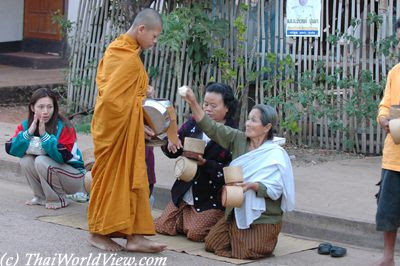
Giving alms
Thai women, kneeling, or Thai men, standing, put food inside the monk’s bowl.
The women cannot touch the monks or his belongings.
Monks are going out for alms everyday around 5 AM to 6 AM, except during the 3 months’
rainy season (July to october). They carry their bowl with both hands and close
to the belly.
As a city, district or village can contain several Buddhist temples,
the abbots agree together on the path reserved for each temple.
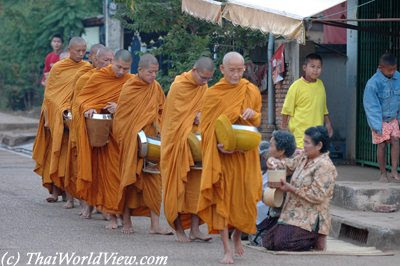
Giving alms
The monks do not thank for the food as they give opportunity for the laypeople to
do good deeds and earn merits.
Going out for alms is called “BIN THA BAT”
(บิณฑบาตร).
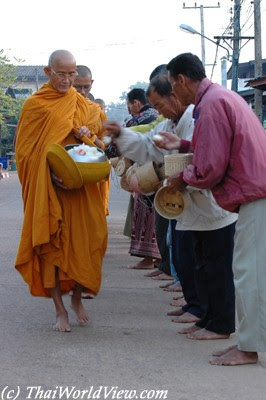
Giving alms
Alms bowl (บาตร) is the monk’s emblem.
According to Buddhist rules, it is the only dish that monks can possess.
Traditionaly, the housewife or her youngest daughter are waiting
in front of the house. They greet the monks through a “WAI” (ไหว้)
and put food inside the bowl.
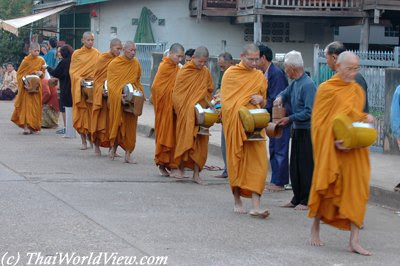
Giving alms
The monk shall not look at the women, neither thank them. No words are said.
If a young novice receives food from his mother, he can bless her.
The monks walk bare foot and shall accept any food given to them.

Going out for alms
If the bowl is full, the monk puts the lid (ฝาบาตร)
on it in order that laypeople can put a few last food offerings on the lid.
Traditionaly, rice offered shall be recently cooked rice.
People also offer curry dishes, sweets, fruits, flowers, incense sticks…
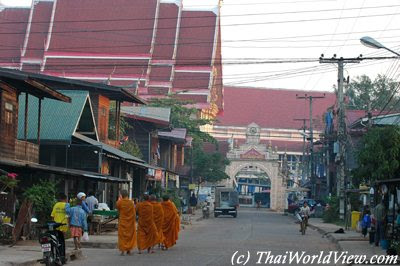
Going out for alms
Food offered shall always be the best. Giving good allows receiving
good deeds and merits.
Then back to the pagoda, the monks share the received food
inside the Buddhist community.

Going out for alms
People, who just gave alms to monks, can share this offering with deceased ancestors
through a small ceremony called “KRUAT NAM” (กรวดน้ำ).
This libation allows giving merits to defunct ancestors. Water is put
inside the cooking pot and pour down slowly on the right hand forefinger to the soil. So merits go down
from the cooking pot through the hand to the earth. The Earth deity
“MAE THORANI” (แม่ธรณี) shall give the merits to
the right ancestors.

Going out for alms
Traditionaly, if a monk bowl falls in front of a house, it is seen as a bad omen.
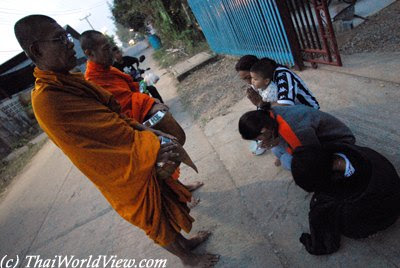
Giving alms
Some Thai people give alms everyday but some give alms on specific events only such as
Buddhist holy days (“WAN PHRA” - วันพระ),
birthday and so on… On such occasion, they can request a blessing from the monks.
28-08-2018. But the site was closed on that day and many who wanted to
apply for the course was disappointed.with the following message:
Yathaa bubbulakam passe yathaa passe mariicikam…
Just as one would look upon a bubble or a mirage…
Sorry!
The page you requested has been moved or no longer exists.
You may wish to visit our home page to see what’s new or use the search box to try to locate the document you were seeking.
Vipassana Fellowship
Meditation Course - September 2018
Meditation Course - September 2018
This is the application form for the 10 week online meditation course from Vipassana Fellowship.
The course begins on Saturday 29th September and ends on Friday 7th December 2018.
Page 1 of 5 - Contact
20%
Name * First Last
Address *
Street Address City State / Province / Region Postal / Zip Code
Country
Phone *
Email *
Confirm Email Address *
Alternative Email
$0.00
Total
http://www.vipassana.com/course/app.phphttp://www.vipassana.com/course/app.php
The Meditation Course
Application Details
Our
next available course will begin in September 2018 and registration is
now open. To ensure a place, early application is advisable. The course
runs from September 29th - December 7th, 2018.
Subscription Fees For New Course Participants
The
subscription rate for our current course is US $140. This brings 10
weeks’ tuition via Vipassana Fellowship’s Online Course Campus, personal
support for your practice (by e-mail and online discussion) from the
course teacher and includes specially recorded audio guided meditations
and chants.
Please note that anyone in genuine financial
difficulty may contact us before applying to discuss paying by
instalments over a longer term or, when necessary, a reduced
subscription fee.
Homelands Places
Our FREE subscription offer for South Asia
If
you were born and currently live in one of the traditional homelands of
early Theravada Buddhism we are able to offer a limited number of
places on each online course free of charge. This scheme applies to
those native to - and permanently resident in - India, Sri Lanka,
Thailand, Nepal, Burma, Pakistan, Cambodia and Laos. You must also be
able to access the course daily from your home country. Homelands places
are always in high demand and it is advisable to apply as soon as
possible. The special Homelands form for our September course will be
available here on August 29th. Please do not use the standard
application form below for Homelands places.
Subscriptions For Previous Participants
Concessionary rates available to all previous participants
If
you have participated in any of our earlier online courses you are
welcome to join us for the new session at a substantial discount: the
standard version for US $80 including the downloadable audio material.
Note: Our Parisa scheme is an alternative way of subscribing that
provides ongoing support, access to future courses and new monthly
material.
Registration
If you would like to register for
the forthcoming course, you will need to complete our online application
and pay the subscription to secure a place. Once we have received your
form and payment we will normally write to you within 7 days to confirm
your place.
Completion of our application form
We need to
know a little about you if we are to be able to support you during the
course. We’ll ask you for your contact details and also that you tell us
something about your experience and reason for wanting to take the
course. This provides the opportunity, if you wish, to let the course
leader know of any issues that may need to be taken into account during
the 10 weeks we will be together. Payment can be securely made through
Stripe using most Credit or Debit cards.
Please ensure you have
read the Course Description and Frequently Asked Questions. You may also
find it useful to read the Terms and Conditions that govern the use of
this site, our software, and which include our privacy and refund
policies for your protection.
Apply now for our September 2018 ten week course.
Click here to use our course.org secure server.
SSL Certificate
http://www.vipassana.com/course/
Home
Mindfulness
meditation from the Theravada tradition for the spiritual development
of people of all faiths & none. Online courses & support since
1997
Practical Training
Meditation Resources
Buddhist Context
Pali Canon
Newsletter
Vipassana Fellowship Meditation Course
An established online course in Mindfulness Meditation as found in the Serenity and Insight traditions of early Buddhism.
Please join us for one of our 10 week courses:
June 2018 (10 week course: June 16th - August 24th)
September 2018 (10 week course: September 29th - December 7th) - Registration now available.
January 2019 (10 week course)
Vipassana
Fellowship’s online meditation courses have been offered since 1997 and
have proven helpful to meditators in many countries around the world.
The main text is based on a tried and tested format and serves as a
practical introduction to samatha (tranquility) and vipassana (insight)
techniques from the Theravada tradition of Buddhism. Intended primarily
for beginners, the 10 week course is also suitable for experienced
meditators who wish to explore different aspects of the tradition. The
emphasis is on building a sustainable and balanced meditation practice
that is compatible with lay life. The course is led by Andrew Quernmore,
a meditation teacher for over 20 years and with a personal meditation
practice of more than 35 years. Andrew trained with teachers in Sri
Lanka and in England and has taught meditation in London colleges and at
retreats in the UK, Europe and Asia. The course is delivered wholly
online in our Course Campus.
Course Outline
Frequently Asked Questions
Application Form
Testimonials
Already enrolled? Log-in here
Parisa - Our support scheme for previous participants
Comments from participants
Participants in our earlier course wrote:
“What
a wonderful experience this has been. The course was so well organized,
easily accessible, affordable, systematic, and comprehensive. I will
always be grateful for this experience in my journey.” L, USA
“I found the course immensely useful, accessible and extremely thought-provoking.” - A, UK
“I
didn’t finish everything, but what I was able to experience was
profound. Thank you so much for the tremendous wealth of thinking and
peace contained within your course.” - N, USA
“I found it very
helpful and well structured. It helped me establish a daily practice
throughout the duration and to learn a lot” - I, Argentina
“When I
applied to join the course, I was struggling in my practice and had
lost heart. I can’t sufficiently express my appreciation and gratitude
for the wonderful resource you offer. The content was immediately
engaging, and was throughout delivered with clarity and thoughtful care.
Perhaps I can best express feedback in terms of how differently things
feel having completed the course. The words that pop up are refreshment,
reinvigorated, revival; joyful reconnection and commitment. Thank you.”
- E, UK
“Before joining this course I was doing meditation but
not with such discipline and without any structure. This course showed
me many beautiful aspects of meditation which I have read before but not
experienced. My sincere thanks to you and all people working for this
online course. This is great help to people who cannot go physically to
Ashrams to attend and practice.” S, India
“I greatly enjoyed it! And found it to be a great introduction to various meditation techniques.” - M, Hong Kong
“I
very much appreciated the structure of the course and the exercises,
which made it easy to integrate them into normal everyday life. Not
being in a retreat but living in normal circumstances while practicing
the exercises has enabled me to more and more notice phenomena arising
in particular situations and I indeed started to learn and observe how
suffering is created in everyday life situations and what suffering
feels like. (A bit like ‘training on the job.’) Also I noticed insights
arising, literally out of nowhere.” - A, Germany
“am very happy
with the offered course, and Andrew’s use of personal perspective really
helped me understand things better. Although I’ve previously used
Vipassana meditation, this course really brought it together for me.” J,
USA
“Meditations of Loving-Kindness, Compassion, Appreciative
Joy, Equanimity etc. will no doubt help to maintain an emotional balance
in the midst of discouraging vicissitudes of life. All in all the
package was complete, precise and well crafted for the development of
mind. Thank you, with your help I began the journey. And hope, will
continue till the end.” J, India
“Truly memorable experience. Am
determined more than ever to continue my practice and perpetual
exploration. Thanks for taking us through this journey.” G, India
“I
enjoyed very much the January meditation course. Although I’ve done a
few of those 10 day courses, this online course taught me new techniques
that I find helpful. I also enjoyed the readings and found Andrew’s
style of writing to be very pleasing to read. He doesn’t shove the text
down one’s throat. Instead, he imparts the information in a way which is
easy to read and leaves the reader feeling at ease - as though this is
really doable if only one approaches it with a relaxed and calm
attitude. Thanks Andrew! I hope we meet someday!” - A, USA
Recent comments:
“This course has been very helpful to me in establishing a daily practice.” - D, USA
“I have learned much and my meditation practice has benefitted greatly…” - C, Australia
“I
would like to thank you for your well structured, informative and
personal course, it helped me for 3 months in a great way and left me
determine to continue meditation practice…” - T, Qatar
“Wonderful
course. Like a guided stroll through a wondrous rainforest. Rough
terrain and stormy weather were dealt with gently but profoundly. Beauty
was to be rejoiced in. Student discussion was fun and educative. Both
my meditation practise and my Buddhism grew exponentially. Thank you
Andrew and all participants.” -S, Australia
“I enjoyed your course. I meditate each morning…” - A, USA
“Thank you very much for the Vipassana course! … I kept up, learned, and benefitted in what feels like a major way.” - M, USA
“Impermanence!
I do not like endings. Thank you so much for offering this meditation
course to the world. I was so happy to find it.” - S, Canada
“Hi,
I have just completed the course. It was fantastic, life altering. Feel
very sad that it is finished. I have now established a daily meditation
practice and will try to find a group in Sydney to further my dhamma
practice. Thank you, it really has been a remarkable experience. I will
join the Parisa and stay in touch with this organization. I have NO
complaints only gratitude. Thank you.” - K, Australia
“As we near
the end of the course I just want to say ‘thank you’ for your work on
it and share some of my thinking and experience at thsi point. Ive found
the different aproaches to meditation interesting and useful and have
appreciated your focus on practicalities. The frequently asked questions
have helped to avoid my inundating you with questions, as many people
have clearly walked the path before asking them! … I am happy that it
is a practical philosophy for living an ethical life, I like the
emphasis on acting skillfully, feel that individual responsibility for
ones actions (rather than relying on redemption) makes sense … Thank
you for a very accessible path! - J, UK
Earlier comments
Dhamma Essay:
The Five Spiritual Faculties by Bhikkhu Bodhi
Meditation | Resources | Pali Canon | Training | Parisa
Audio | Links | Books | Newsletter | Feedback | Donate
to know - to shape - to liberate
Site Copyright © 2018, Vipassana Fellowship Ltd. [Terms of Service & Privacy Policy]
Analytic Insight Net -

University and related NEWS through http://sarvajan.ambedkar.org in
105 CLASSICAL LANGUAGES
Nikhilavijjālaya ca ñātibhūta Pavatti Nissāya
http://sarvajan.ambedkar.org anto 105 Seṭṭhaganthāyatta Bhāsā
an Online GOOD NEWS CHANNEL FOR WELFARE, HAPPINESS AND PEACE FOR ALL
SOCIETIES Catering to more than 3000 Emails: 200 WhatsApp, Facebook and
Twitter.
is the most Positive Energy of informative and research oriented site propagating the teachings of the Awakened One with Awareness the Buddha and on Techno-Politico-Socio Transformation and Economic Emancipation Movement followed by millions of people all over the world.
Rendering
exact translation as a lesson of this University in one’s mother tongue
to this Google Translation and propagation entitles to become a Stream
Enterer (Sottapanna) and to attain Eternal Bliss as a Final Goal.

Classical Buddhism (Teachings of the Awakened One with Awareness) belong to the world, and everyone have exclusive rights:JC
Free Online
(A1wAM)+ ioT (insight-net of Things) - the art of Giving, taking and Living to attain Eternal Bliss
as Final Goal through Electronic Visual Communication Course on
Political Science -Techno-Politico-Socio Transformation and Economic
Emancipation Movement (TPSTEEM)



